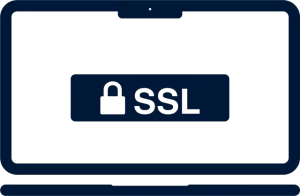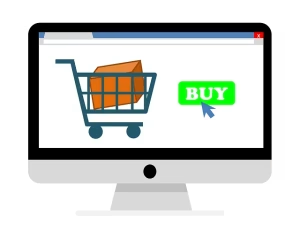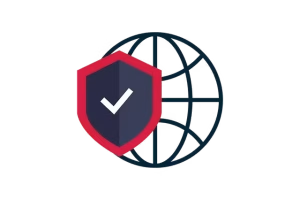The Digital Handshake: Establishing Initial Trust
Analysis of e-commerce data consistently reveals a troubling statistic for small business owners: nearly seven out of every ten online shopping carts are abandoned before a purchase is completed. While some of this is due to customers comparison shopping or saving items for later, a significant percentage stems from a far more fundamental issue: a lack of trust.
In the traditional world of brick-and-mortar stores, trust is built through face-to-face interaction, a professional environment, and the physical presence of a business. Online, however, a business exists as a collection of pixels on a screen. For a new visitor, there is an immediate and unspoken question: “Is this website legitimate, and is my information safe here?” This moment of hesitation is where countless sales are lost.
This article will serve as a comprehensive guide to understanding one of the most effective tools for overcoming that hesitation. We will conduct a data-driven analysis of the importance of website trust seals, breaking down what they are, their proven effect on customer behavior, and how you can implement them to fortify your digital storefront and convert uncertain visitors into confident customers.
Core Concepts: What is a Trust Seal? A Technical Breakdown

At its most basic, a trust seal—often called a trust badge—is a small image placed on a website that is meant to show visitors the site is secure and trustworthy. Think of it like a security guard’s badge or a sticker in a store window showing they are protected by a well-known security company. It’s a quick, visual signal that says, “This place is safe.”
However, it’s critical to understand that a real trust seal is much more than just a picture. Legitimate seals are provided by a third-party company that has verified something specific about your business. When you get a seal from a company like DigiCert or McAfee, you aren’t just downloading an image. You are typically given a small piece of code, usually JavaScript, to add to your website. This code does two things:
- It displays the seal’s image.
- It makes the seal “live.” This means when a visitor clicks on the seal, a pop-up or a new page opens that is hosted by the third-party company. This verification page shows details about your business and confirms that the seal is authentic and currently active.
This clickable verification is what separates a real, trust-building seal from a fake one that is just a copied image. Savvy online shoppers know to look for this interactivity.
A common point of confusion is the difference between an SSL certificate and a trust seal. They are related but serve different functions. An SSL (Secure Sockets Layer) certificate is the technology that encrypts the data traveling between your customer’s browser and your website server. It’s what creates the secure https:// connection and the little padlock icon in the browser bar. The SSL certificate is the actual security guard.
The SSL trust seal, on the other hand, is the visual badge that the security guard wears. It’s the logo from the company that provided the SSL certificate (like DigiCert or Comodo) that you can display on your site to advertise that you have this security in place. You need the SSL technology to be secure, but you use the trust seal to make sure your visitors know you are secure.
The Data-Driven Impact: Quantifying the Effect of Trust Seals on Conversions

Business decisions should be guided by data, not just feelings. When analyzing the question, “Do trust seals really work?” the data is overwhelmingly clear: yes, they do. For small businesses, where every sale matters, understanding this impact is vital. The strategic use of trust seals is a core component of Conversion Rate Optimization (CRO), the practice of increasing the percentage of website visitors who take a desired action.
Multiple studies from e-commerce research groups like the Baymard Institute have explored why users abandon their shopping carts. While shipping costs are a major factor, a significant number of users—around 18% in some studies—report leaving a checkout process because they “didn’t trust the site with their credit card information.” This is a problem that trust seals are specifically designed to solve.
Placing a well-recognized trust seal in a key location, like a checkout page, can have a measurable impact on several key business metrics:
- Reduced Cart Abandonment: This is the most direct benefit. When a customer is about to enter their most sensitive financial information, a familiar security logo (like McAfee or Norton) or a payment logo (like Visa or PayPal) provides a final push of reassurance, reducing last-second hesitation.
- Increased Overall Conversion Rate: By building trust from the moment a visitor lands on your site, seals can make the entire browsing and shopping experience feel safer. This increased confidence leads to a higher percentage of visitors turning into buyers. Even a small increase, from a 1% to a 1.5% conversion rate, represents a 50% increase in sales.
- Higher Average Order Value (AOV): When customers feel secure, they are often more comfortable making larger purchases. The trust established by the seals can reduce their perceived risk, making them more willing to add an extra item to their cart or choose a more expensive option.
- Improved Lead Generation: Trust seals aren’t just for e-commerce. If your business relies on customers filling out a contact form with their name, email, and phone number, a privacy or security seal placed near that form can increase submissions. It tells users that their personal data will be handled responsibly.
The key takeaway is that trust is a form of currency online. By investing in and displaying signals of trust, you are removing a major barrier to purchase and directly improving your bottom line.
A Taxonomy of Trust: Which Trust Badges Are Best?

The question “Which trust badge is the best?” is common, but it’s slightly misleading. It’s like asking, “What is the best tool?” The answer depends on the job you need to do. Different trust seals communicate different things, and the most effective strategy is to use a combination of seals that cover all the major areas of customer concern.
Here is a breakdown of the main categories of trust seals and the specific message they send:
1. SSL Seals (Data Security)
- Purpose: These seals prove that the connection to your website is encrypted and that any data your visitors submit—like passwords or credit card numbers—is protected from hackers.
- Who Needs Them: Every website. If you have so much as a simple contact form, you need SSL. Google flags sites without
https://as “Not Secure,” which is a major trust killer. - Key Entities: DigiCert (which now owns the well-known Norton Secured Seal), Comodo, GeoTrust, Sectigo.
2. Security & Malware Seals (Site Integrity)
- Purpose: These seals show that the website is regularly scanned for malware, viruses, and other security vulnerabilities. It tells visitors that the site itself is clean and won’t harm their computer.
- Who Needs Them: Highly recommended for all businesses, but especially e-commerce stores where the risk of a security breach is most damaging.
- Key Entities: McAfee SECURE, SiteLock, Trustwave. The McAfee seal is one of the most recognized and tested for boosting conversions.
3. Business Accreditation & Review Seals (Business Legitimacy)
- Purpose: These seals prove that your business is a real, legitimate entity that adheres to certain standards of quality and customer service. They answer the question, “Is this a real company or a scam?”
- Who Needs Them: Any business looking to establish its credibility, especially if you are not a well-known brand. They are excellent for service-based businesses as well as e-commerce.
- Key Entities: Better Business Bureau (BBB) Accredited Business, Trustpilot, Google Customer Reviews. The BBB seal is particularly powerful in North America for signaling long-term legitimacy.
4. Accepted Payment Seals (Transactional Trust)
- Purpose: These are simply the logos of the payment methods you accept. They serve a dual function: they are practical (telling customers how they can pay) and they build trust through association. By showing you are trusted by major financial companies, you borrow some of their credibility.
- Who Needs Them: All e-commerce websites.
- Key Entities: Visa, Mastercard, American Express, PayPal Verified, Stripe, Apple Pay. The PayPal logo is especially effective, as many customers trust PayPal’s platform to handle their financial details securely.
5. Privacy Seals (Data Handling)
- Purpose: These seals demonstrate that your business has a clear privacy policy and complies with regulations about how it collects, uses, and protects customer data.
- Who Needs Them: Businesses that collect a lot of user data, operate in regions with strict privacy laws (like Europe with GDPR), or want to reassure users who are sensitive about their personal information.
- Key Entities: TRUSTe, CPA WebTrust.
A good strategy for a small e-commerce business would be to use an SSL seal, a security seal like McAfee, and the logos of the payment methods you accept. This combination covers data security, site integrity, and transactional trust.
Implementation Guide: How to Get a Trust Badge on Your Website
Getting trust seals on your website can seem technical, but the process is quite straightforward. Here is a step-by-step guide for a typical small business owner.
Step 1: Obtain an SSL Certificate and Seal
This is the most important first step. Most modern web hosting companies (like GoDaddy, Bluehost, or SiteGround) offer free SSL certificates from Let’s Encrypt with their hosting plans. You can usually activate this with a single click in your hosting control panel. For a more recognized seal, you can purchase a premium SSL from a company like DigiCert. Once your SSL is active, visit the certificate provider’s website. They will have a section where you can get the code for your corresponding trust seal to add to your site.
Step 2: Sign Up for a Security Service
Choose a service like McAfee SECURE or SiteLock. You will sign up on their website and register your domain. Their service will then begin scanning your site for vulnerabilities. Once your site passes the initial scan, they will provide you with the JavaScript code snippet to install their trust seal. This often comes with a dashboard where you can monitor your site’s security status.
Step 3: Gain Business Accreditation (Optional but Recommended)
To get a seal like the BBB Accredited Business seal, you must go through an application process directly with the Better Business Bureau. They will review your business’s history, practices, and customer complaints to ensure you meet their standards. If you are approved, you pay an annual fee and receive the right to display their dynamic seal on your website.
Step 4: Add Payment Logos
This is the easiest step. The companies that process your payments, like PayPal, Stripe, or your merchant account provider, want you to show their logos. They typically have a “brand assets” or “logos” page on their website where you can download official images. You can then add these images to your website’s footer or checkout page.
Step 5: Code Integration
For the “live” seals (SSL and security), you will need to add the code snippet they provide to your website. If you are using a platform like Shopify or BigCommerce, there is often an app or a simple setting to do this. If you use WordPress, you can typically add the code to a header/footer plugin or a widget. If you are not comfortable with this, it is a very quick and inexpensive task for any web developer.
Strategic Placement: Maximizing Seal Visibility and Efficacy
Simply having trust seals is only half the battle; you must place them where they will have the greatest impact. Think of it like placing fire extinguishers in a building—you put them in high-traffic areas and near potential hazards. The same logic applies to trust seals.
- The Homepage: Placing one or two of your most powerful seals (like a BBB or McAfee seal) on your homepage helps to establish trust from the very first impression. It can reduce your bounce rate, which is the percentage of visitors who leave after viewing only one page.
- The Website Footer: The footer is a standard, expected location for trust seals. Visitors often scroll down to the footer to find contact information, privacy policies, and other signs of a legitimate business. Placing your seals here provides a persistent, site-wide signal of security and legitimacy.
- Product Pages: For e-commerce sites, placing seals near the “Add to Cart” button can help reassure customers at a key decision-making moment. It subtly reinforces that the entire shopping process is secure.
- The Checkout and Payment Pages: This is the single most important location. The checkout process is the point of maximum friction and anxiety for a customer. They are about to hand over their money and personal information. Displaying your SSL, security, and payment logos prominently near the fields where they enter their credit card details is critical. This visual reassurance can be the deciding factor that prevents them from abandoning their cart.
The goal is to anticipate your customer’s moments of doubt and proactively address them with a visual signal of security.
Cost-Benefit Analysis: The Investment in Trust
A common question from small business owners is, “Are trust seals free?” The answer is mixed. Some are, and some require an investment, but it’s essential to analyze the cost in terms of the potential return.
Free Options:
- Payment Logos (Visa, PayPal, etc.): These are always free to use as long as you actually accept those payment methods.
- Basic SSL Seals: If you use a free SSL provider like Let’s Encrypt, they don’t offer a fancy seal, but you still get the
https://padlock, which is the most important trust signal of all.
Paid Options:
- Premium SSL Certificates: These can range from $50 to several hundred dollars per year. They often come with warranties and more recognizable trust seals (like the Norton seal).
- Security Scanning Services: A service like McAfee SECURE might have a free basic plan but charge a monthly or annual fee for more frequent scans and premium features. These fees can range from $100 to $300 per year.
- Business Accreditation: A BBB accreditation can cost several hundred dollars per year, depending on the size of your business.
To understand the value, let’s do a simple Return on Investment (ROI) calculation. Imagine your online store generates $5,000 in sales per month. You decide to pay $200 for a one-year subscription to a security seal. A conservative estimate from case studies suggests such a seal could increase your conversion rate by 3%.
- Increase in sales: $5,000 x 3% = $150 per month.
- Annual increase in sales: $150 x 12 = $1,800.
- Your ROI: ($1,800 Gain – $200 Cost) / $200 Cost = 8.
- This means for every $1 you spent on the seal, you got $8 back in new sales.
When viewed as an investment in your conversion rate, the cost of a premium trust seal often pays for itself many times over.
Common Pitfalls: Inauthentic and Misused Seals
While implementing trust seals is a powerful strategy, there are critical mistakes that can backfire and destroy customer trust instead of building it.
- Using Fake or Copied Seals: This is the worst possible mistake. Some website owners will simply find an image of a Norton or BBB seal on Google Images and put it on their site without being a legitimate customer or member. This is deceptive and often illegal. Visitors who click on it and find it doesn’t work will immediately know the site is dishonest, and they will leave and never return.
- “Badge Clutter”: More is not always better. Plastering your site with a dozen different trust seals can make it look cluttered and unprofessional. Worse, it can come across as desperate or even spammy, having the opposite of the intended effect. A better approach is to choose three to five well-recognized, relevant seals that cover the key areas of trust.
- Using Outdated or Expired Seals: If you stop paying for a service, you lose the right to use its seal. Most dynamic seals will stop working or show an error message if your subscription lapses. Displaying an expired seal is a clear signal of unprofessionalism and can make visitors question the overall maintenance and security of your website.
The goal is to be authentic. Genuine, strategically placed, and current trust seals build confidence. Fake, cluttered, or expired ones do active harm to your brand’s reputation.
E-A-T and Semantic SEO: Why Google Cares About Trust
Search Engine Optimization (SEO) is about more than just keywords. Google’s primary goal is to provide its users with the best, most relevant, and most trustworthy results. To do this, they evaluate websites based on a concept they call E-A-T:
- Expertise: Is the content created by an expert?
- Authoritativeness: Is this website a respected authority in its field?
- Trustworthiness: Is this website safe, secure, and legitimate?
While a trust seal is not a direct, technical ranking factor like a keyword in your title tag, it heavily influences the “Trustworthiness” component of E-A-T. Google is smart enough to understand what these seals signify.
More importantly, trust seals have a powerful indirect effect on your SEO. When users trust your site, their behavior changes in ways that Google measures:
- Lower Bounce Rate: They are less likely to leave immediately.
- Higher Dwell Time: They spend more time on your site.
- Higher Click-Through Rate (CTR): Over time, as your brand builds a reputation for being trustworthy, more people will click on your result in the search listings.
These positive user signals tell Google that people like and trust your website, which can lead to higher search rankings over time. Therefore, building user trust with seals is also a long-term SEO strategy.
Conclusion: Finalizing the Digital Architecture of Trust
In the impersonal world of the internet, trust is the invisible architecture that supports every successful transaction. For small businesses, building this trust is not an optional extra; it is a fundamental requirement for survival and growth. Website trust seals are among the most efficient and effective tools for constructing this architecture. They are not merely decorative icons; they are functional, data-backed instruments that provide psychological reassurance to your visitors, directly address their security concerns, and produce measurable improvements in sales and leads.
Your task now is to conduct a “trust audit” of your own website. Look at it from the perspective of a brand-new, skeptical customer. Identify the moments in their journey where doubt might creep in—the homepage, the contact form, and especially the final checkout page. By strategically placing authentic, relevant trust seals at these critical points, you can replace that doubt with confidence, transforming hesitant visitors into loyal customers and building a stronger, more profitable online business.






